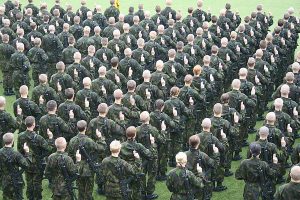2018-02-15 By Robbin Laird
Helsinki, Finland
During my current visit to Helsinki, I had a chance to meet and to discuss the way ahead for Finnish defense with Janne Kuusela, Director General, Defense Policy Department of the Finnish Ministry of Defence.
According to the Finnish Ministry of Defence website:
The Defence Policy Department is responsible for assessing the development of the security and defence policy environment.
The Department provides the grounds for defence policy and the planning basis for the defence forces.
It deals with matters concerning general national defence capability, conscription, military crisis management, peace support operations and disarmament and arms control.
The department consists of four units:
- Defence Cooperation Unit
- National Defence Unit
- Research Unit
- Scientific Advisory Board for Defence
During our discussion, we focused on four key issues.
Focus on Territorial Defense
First, Kuusela underscored that Finland has never shifted from its basic defense focus on the priority for the defense of Finnish territory.
While many European states, de-emphasized national or territorial defense, and shifted their forces to specialized force packages useful for working in coalition inside and outside of Europe.
“We have bought specialized equipment for some engagements, such as desert uniforms.
“But by and large our focus has been clearly upon territorial defense.
“When the Crimean crisis occurred, it was not an event that forced us to refocus on territorial defense. We were there already.”
Conscription and Defending the Homeland
Second, conscription has been an important part of Finnish defense, but there is an increasing emphasis on enhanced readiness.

This means shifting emphasis from training conscripts to getting as well better combat readiness out of the mobilization force.
He argued that one advantage of the conscription process is that the Finnish government was in a position to identify candidates for the professional military and with the increased “tech savy” required to man a 21st century force, this also allowed for exposure to some of the best candidates to serve in the military to provide for the relevant expertise for a 21st century force.
“It is a two-way street with the population.
“The reservists bring back a lot of current information about technology and society which can then be tapped by the professional military as well as the professional military providing up to date information on the evolution of military systems.
“I think this is a key capability as new equipment is more technologically sophisticated.”
Shaping a Process of Change: A Priority on Security of Supply and Distributed Ops
Third, change is being made to enhance inherent advantages of the Finnish defense approach.
C2 is an especially important part of the Finnish military given the size and location of the country and the Finns have built a modern C2 system which they leverage for the military operation son their territory.
It is also the case, that the trend to shape distributed operational forces has a solid foundation in Finland as well for in their training and preparation they disperse force away from the training bases to flexible operational settings within the country.
“We have also modified our legislation to allow for more rapid and effective crisis decision making which is a key requirement for the new situation as well.”
In the Finnish defense policy document published last year, the core point underscored was that the threshold for the use of military force is lower and the time to respond shorter.
Obviously, given this characterization, C2 and crisis management systems are central pieces for shaping a 21st century defense and security capability for Finland.
This also highlights the importance of the security of supply.
“Given the short time span when you have a crisis going on, you need to fight with what you have in your stocks at that given moment, so you can’t expect to fly overseas to buy more.”
“We have heard a lot about anti-access and area denial.
“But that is our objective as well for the defense of Finland. “we’ve designed our defense so that if there is crisis we will not use our bases which we used in peacetime.
“The garrisons and the air bases and naval base will be empty, and our military will operate all around the country.
“Because we have mobilization force and we have to store our gear in the right kind of places so they are secure but they’re also available for distribution in times of crisis.”
Shaping a Modernization Effort
Fourth, the foundation is solid but needs modernization in terms of equipment and enhanced capabilities for joint and coalition operations.
This is being done in two key ways.
Finland is building out its partnerships and working relationship within the region and with the United States and other European states.
For example, with regard to the security of supply issue, the Nordics are now enhancing their collaboration to ensure better security of supply for the region.
“Last year, we held the rotating chairmanship of Nordic Defense Cooperation, and one of the main issues on the agenda was military security of supply and what can we do with our Nordic partners.
“This year Norway is carrying on for where we left off, and continuing a serious look at how can we join forces better among neighbors in the Nordic area.”
The second way is by modernization of ground equipment, shifting from older artillery pieces to more mobile longer-range capabilities and modernizing the navy and air force.
There is a concern with the cost necessary to modernize the force, but by enhancing joint operations and leveraging the capabilities of the new systems to be more efficient in terms of modernization and support, the case can be made that an effective modernization path can be forged.
This is crucial otherwise in Kuusela’s view we risk losing public support for investment in the defense systems which are needed.
“We understand that the dynamics of the integrated battlespace of the 21st century is quite different from the operational approaches of the 1980s and we need to adjust to the new realities.
“And in our region, for example, the Norwegians are introducing the F-35 and the sensors onboard the aircraft will have a significant impact on how one shapes a joint fires approach.”
In short, the Finns are shaping a way ahead for themselves, with their neighbors and are key stakeholder in shaping a new approach to Nordic and Northern European defense.
Editor’s Note: A good example of the changes in Finnish defense policy is highlighted in the following story published last year:
Defence Secretary of the UK: JEF forces ready to assist Finland – “Finland is not alone”
On Friday in Stockholm, Finland will sign an agreement on joining the 10 000-strong rapid response forces led by the UK.
The JEF (Joint Expeditionary Force) can be deployed to military operations anywhere in the world, including Finnish soil.
The UK’s contribution to the forces, which will be fully operational by the end of 2018, will include the lead commando, airborne, armoured, aviation, air and maritime task groups.
The UK Secretary of State for Defence Michael Fallon says in an interview with Lännen Media that the JEF can be deployed more rapidly and flexibly in an actual situation than the combat forces of NATO or the EU.
“The JEF is not NATO. It is NATO’s duty to respond to any Russian aggression, but NATO has 29 and the EU has 28 member states. They are extremely large organisations where decision-making is inevitably bureaucratic. The JEF is more adaptable and agile and can be deployed very quickly to humanitarian tasks, to rescue our citizens from crisis hotspots or to conduct more minor military missions,” Fallon describes.
Fallon: “Finland is not alone – it can be expected that our military cooperation with Finland will increase”
Fallon stresses that the UK wishes to enhance its bilateral defence cooperation with Finland. In a worst case scenario, could the government of Finland call London and request for military assistance?
“We help each other. We are already doing so through multiple groups, such as the Northern Group. The JEF provides yet another collective form of partnership, and its core is formed by the UK, The Netherlands, the Baltic states, Denmark and Norway.”
“So the answer is yes. Finland is not alone and Finland should not be alone,” says Fallon.
The history behind the JEF cooperation is interesting. Seven founding countries signed the agreement on 4 September, 2014, at the NATO Wales Summit on the air-defence destroyer HMS Duncan of the Royal Navy.
Russia had annexed Crimea in the previous spring. Russian troops had invaded Eastern Ukraine. In Wales, NATO decided to reinforce its NRF rapid response forces whose military exercises Finland has also participated in.
However, exercises are not the same as actual involvement.
The UK is the largest military power in Western Europe and needs its own national spearhead for demanding international operations. The British established the JEF together with “like-minded partners”, as Fallon describes the allies.
Now, Finland and Sweden are joining the JEF countries. Fallon says that the enhancement of military cooperation is linked to the UK’s separation from the EU.

“Exactly. Since we are leaving the EU, we wish to work even harder to strengthen our other partnerships, our membership in NATO and the JEF and our arrangements in Asia and the Pacific. We must also strengthen our bilateral ties. It can be expected that our military cooperation with Finland will increase,” Fallon stresses.
“I hope that the JEF will bring reassurance to countries like Finland and Sweden”
Peacetime cooperation focuses especially on participation in humanitarian operations under the UN. At the same time, the purpose of extremely rapid combat forces is to reinforce the deterrent, preventing the use of military force to threaten Finland, for example.
“We are like-minded countries and have worked together in the EU. Unfortunately, that will come to an end in two years. We are leaving the political union, which is why we are reinforcing our military partnerships. We are the lead nation of NATO’s Enhanced Forward Presence deployment in Estonia, but are also forming smaller and highly practical JEF task groups,” says Fallon.
He goes on to send a security policy message to Finns – and to the neighbours of Finland.
“I hope that the JEF will bring reassurance to countries like Finland and Sweden. Membership provides them with groups of friends who are ready to take action and provide assistance,” says Fallon.
One of the elements of the JEF are the British commandos.
Director-General Janne Kuusela: “We must make arrangements that enable that assistance while the going is good”
Director-General Janne Kuusela from The Defence Policy Department of the Ministry of Defence of Finland points out that it is too late to try to build aid mechanisms in a crisis.
“If and when we hope to receive assistance, we must make arrangements that enable that assistance while the going is good,” says Kuusela.
On 1 July, acts will enter into force in Finland to enable the provision of and request for military assistance.
 Janne Kuusela, Director General, Defence Policy Department, Ministry of Defence, Finland
Janne Kuusela, Director General, Defence Policy Department, Ministry of Defence, Finland
The force headquarters of the JEF were tested last year in Cornwall.
“This year, we will organise a Joint Venture exercise where we develop the forces towards becoming fully operational. It is entirely up to Finland to decide on the kinds of troops it considers appropriate for the JEF, which is a club of volunteers. Not every country is expected to take part in every mission,” Fallon points out.
Fallon says the JEF may train in Finland and elsewhere in the Baltic Sea region in the future.
According to Kuusela, Finland could initially offer an infantry company or, for instance, an NBC company specialising in the prevention of chemical threats. The company is about 200-strong and the NBC is about 50-strong in international operations.
“The JEF is probably faster”
Fallon emphasises the speed of the JEF. There is no formal decision-making mechanism, so, according to Fallon, the special forces of the JEF should be on location faster than e.g. NATO’s VJTF spearhead force, which must be ready to deploy within 48 hours.
“We want to keep the operations relatively informal and agile. The JEF is probably faster. I wish to emphasise that it is a group of like-minded members, separate from the NATO, who work together in practical situations.”
“The JEF is not designed against any particular threat, but as member of the JEF, Finland and Sweden can consider the other seven countries their natural allies,” Fallon defines.
During times of peace, the JEF may work to prevent dangerous diseases, evacuate citizens of member countries from crises or hijackings and prevent genocides, says Fallon.
“The best example that I can give of the JEF’s activities is the UK contribution to the prevention of Ebola in Sierra Leone where we delivered a hospital ship.”
“Whether the problem is in Tripoli, Beirut or Rwanda, and whether it be a British, Dutch or Norwegian plane that is deployed, the forces of the other countries may join in,” says Fallon.
Although the JEF is not NATO, one must ask about the threat that Russia poses in the Baltic Sea as Finland joins the rapid response forces of like-minded countries.
“We have seen a much more aggressive Russia in the past three years: the annexation of Crimea, the destabilisation of Eastern Ukraine and increased aerial activity and submarine operations. We will respond to the actions of Russia, but that will be done through NATO,” states Fallon.
Outside NATO, European military powers are rapidly enhancing their cooperation, and Finland is involved in this process through various arrangements.
Fallon says that the rapid response forces of the UK and France are prepared to join forces, if necessary.
“We are also enhancing our defence relations with Germany. These are new relations,” says Fallon, emphasising the UK’s strong will to defend Western Europe, which Finland also belongs to.


